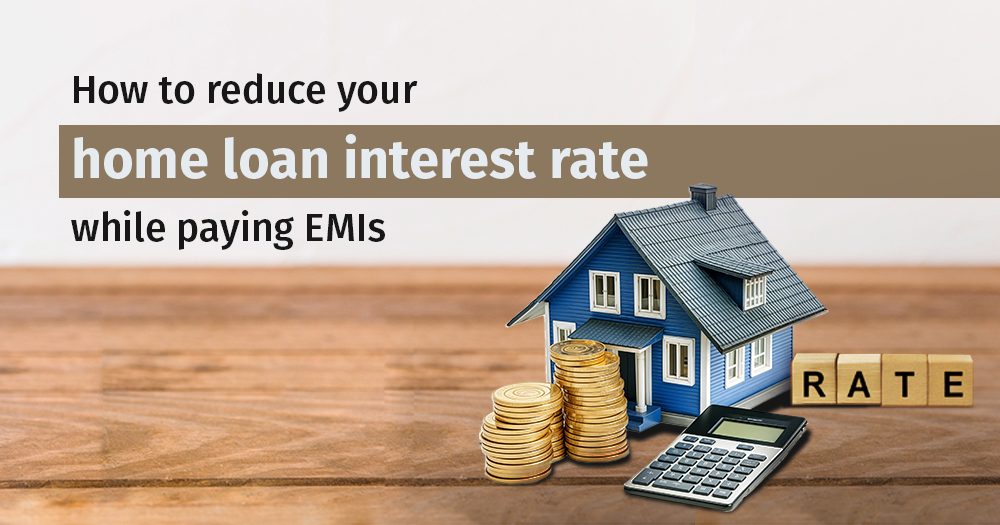Owning a home is a dream for many and is often made possible through a home loan. While securing a home loan can help fulfil this dream, the financial commitment of paying equated monthly instalments (EMIs) for 15 to 25 years can be daunting. Home loans typically come with long repayment tenures, during which a substantial portion of the payments goes toward interest. As a result, many homeowners look for ways to lower their home loan interest rates. It allows them to repay their loans more quickly and move past the biggest debt of their lives.
Banks Start Reducing Home Loan Interest Rates After RBI Repo Rate Cut
On February 7, 2025, the Reserve Bank of India (RBI) reduced the repo rate by 25 basis points (bps). Following this announcement, several well-known banks began lowering their home loan interest rates. Other banks will likely follow suit soon. To remain competitive, smaller banks, housing finance companies, and non-banking financial companies (NBFCs) are also expected to offer lower rates shortly. If you are an existing home loan borrower, now may be the perfect time to understand how to reduce your interest rate.
Here are Four Effective Ways to Lower your Home Loan Interest Rate
1) Identify Your Home Loan Interest Rate Regime and Switch to a Lower One if Available
The first step is identifying which interest rate regime applies to your home loan.
If you took out your loan before October 2019, it likely follows the Marginal Cost of Funds Based Lending Rate (MCLR), the base rate, or the Benchmark Prime Lending Rate (BPLR). The Reserve Bank of India (RBI) asked banks to link home loan interest rates to an external benchmark from October 1, 2019. After this date, all new loans were set to the External Benchmark Lending Rate (EBLR). However, existing borrowers were allowed to remain under the old system until they decided to switch.
If you have an older loan, verifying your interest rate regime and understanding your current home loan interest rate is essential. You may want to consider switching if your interest rate is significantly higher than the EBLR. Be aware that banks usually charge a fee for switching from MCLR or BPLR to EBLR.
EBLR refers to a floating interest rate model that banks and financial institutions use to set interest rates for various loans. Unlike traditional benchmarks like the Base Rate or MCLR, EBLR is linked to external benchmarks, such as the central bank’s repo rate, government securities yields, or any other market interest rate indicator. The main advantage of EBLR is its transparency, allowing borrowers to benefit quickly from any reductions in lending rates that reflect broader economic changes.
2)Transfer Home Loan to a Lower Interest Rate Available for New Borrowers
The home loan interest you pay consists of the benchmark interest rate, the spread, and the credit risk premium. Both the spread and the credit risk premium can vary based on the lender’s cost of funds, the credit risk assessment of loan applications, and other parameters.
If you are an existing borrower, there is a chance you may be paying a higher interest rate than the lowest rates offered to new borrowers. This occurs because lenders typically charge a spread above the benchmark rate. If your loan is linked to the External Benchmark Lending Rate (EBLR), it will be affected by any changes in the benchmark rate, as most of these are linked to the repo rate. However, the benefits of these changes are not always automatically passed on to you.
Since higher interest rates are less appealing to new borrowers, banks often lower the rates for new customers by adjusting the spread. On the contrary, banks can be slow to pass these changes on to existing customers.
If new borrowers get significantly lower home loan interest rates than you are currently paying, you could lose money with each EMI. A lower rate could save you lakhs of rupees over the duration of your loan term.
For instance, if you have a home loan outstanding of Rs 50 lakh for 20 years and are paying a 10% interest rate, your current EMI would be Rs 48,251. If the lender is offering an 8.75% interest rate to new borrowers, your EMI would decrease to Rs 44,186 per month. This would result in total savings of Rs 9.76 lakh over the entire loan tenure.
Home Loan Interest Calculation: How Much Will you Save if you Switch to a Lower Interest Rate?
| Old Home Loan Interest Rate | New Home Loan Interest Rate | Interest Rate Reduction | Old Home Loan EMI | New Home Loan EMI | Total Interest Saving During the Tenure |
| 10.50% | 8.75% | 1.75% | Rs 49,919 | Rs 44,186 | Rs 15,78,219 |
| 10.25% | 8.75% | 1.50% | Rs 49,082 | Rs 44,186 | Rs 11,75,192 |
| 10% | 8.75% | 1.25% | Rs 48,251 | Rs 44,186 | Rs 9,75,731 |
| 9.75% | 8.75% | 1.00% | Rs 47,426 | Rs 44,186 | Rs 7,77,674 |
| 9.50% | 8.75% | 0.75% | Rs 46,607 | Rs 44,186 | Rs 5,81,046 |
Assumption: Home loan outstanding of Rs 50 lakh, remaining tenure 20 years
You must keep track of what your lender is offering to new customers. If the rate offered to new customers is significantly lower, consider repricing your loan. The process of repricing the loan with your existing lender is comparatively smooth. Check the loan rates offered by the lender, and if they are substantially lower, speak to them about shifting to a lower rate by paying a fee. For instance, HDFC Bank charges a conversion fee of Rs 5,900 for switching loans to a lower rate.
3) Consider the Option of a Home Loan Balance Transfer
If, after inquiring, you find that your home loan interest rate is higher than what other lenders are offering, or if your current lender does not provide an option to revise your rate, you might consider transferring your loan to a new lender. This process is typically known as a home loan balance transfer—when a borrower moves their existing home loan balance to a different bank.
Before making the switch, understand the costs associated with your home loan balance transfer and whether the terms and conditions set by the new lender are acceptable to you. Remember that lenders typically have eligibility criteria for home loan balance transfers, so your profile must qualify to take advantage of the home loan transfer. It is also important to note that a balance transfer incurs processing fees, administrative charges, and other costs. Instead of focusing solely on the transfer fees, consider the overall net benefit of the transfer.
A balance transfer is worthwhile if your net benefit is more than 0.5%. If you can secure a rate that is at least 0.5% lower, it could lead to significant savings.
Home loan borrowers should explore the balance transfer option only if it results in substantial savings on interest costs, even after accounting for the associated expenses and efforts involved.
You can check how much money you will save on your home loan balance transfer using our loan refinance calculator.
4) Make Partial Prepayment to Lower Your Home Loan EMI
Another effective way to reduce your home loan interest rate is partial prepayment. Each monthly EMI you pay consists of both interest and principal amounts. The higher your outstanding principal, the more interest you pay each month. Therefore, making a partial prepayment can decrease your outstanding principal, subsequently lowering your EMI’s interest portion.
Partial prepayment is applied directly against the principal amount of your home loan. Importantly, there is usually no penalty for making partial prepayments on floating-rate home loans; however, the minimum prepayment amount may differ based on your lender’s policy.
You don’t need to make substantial prepayments—small contributions can still have a significant impact. For example, if you have a Rs 40 lakh home loan for 20 years at an interest rate of 9.5%, your monthly EMI would be Rs 37,285, leading to a total interest payment of Rs 49.48 lakh over the term. If you were to prepay one additional EMI at the start of each year, you could save around Rs 11.73 lakh in total interest and reduce your loan term to approximately 16 years and 1 month instead of the original 20 years.
Borrowers can explore various strategies for planning their prepayments to maximize savings. Check with your lender regarding how much partial payment is allowed against your home loan, and make a strategic plan to prepay your loan without burning a hole in your pocket.
This overview illustrates how you can effectively lower your home loan interest rates. It is normal to feel overwhelmed by the numbers involved. Ultimately, your home should be a source of comfort, not stress. Contact a qualified financial advisor if navigating these calculations is challenging for you. It will help you create a comprehensive plan to effectively manage your home loan burden.









